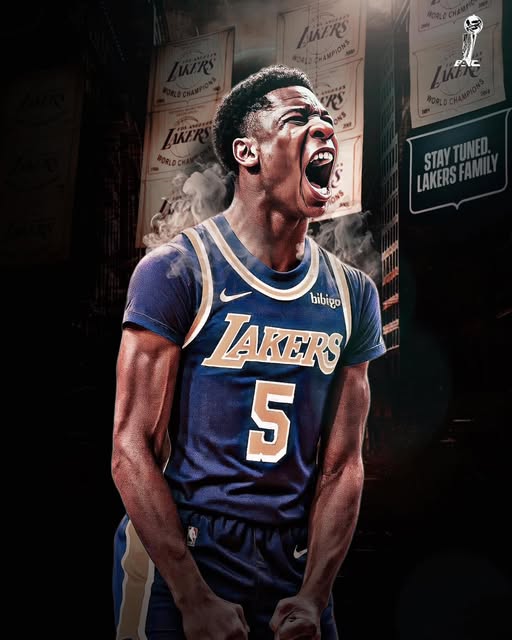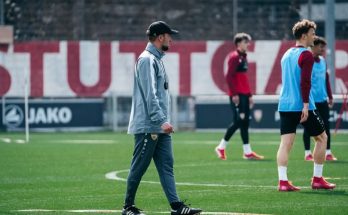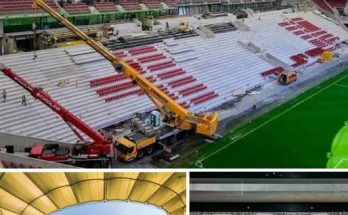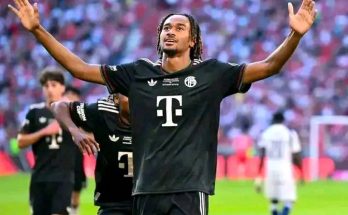In a stunning development that has the basketball world buzzing, the Los Angeles Lakers have emerged as the frontrunners to land elite prospect Ace Bailey if the Utah Jazz decide to cut ties with the electrifying 5th overall pick. The latest odds place the Lakers at +235 to sign Bailey, putting them ahead of other contenders like the Dallas Mavericks (+350) and a host of quietly interested franchises. The potential availability of Bailey—already a headline-making talent before he ever steps foot in an NBA game—has instantly become one of the biggest stories of the offseason.
This situation is unprecedented in many ways. A player selected in the top five of the NBA Draft rarely becomes a potential free agent before even logging significant court time. But Bailey’s unique case—defined by raw talent, growing questions about fit, and rumblings of internal tension in Utah—has opened a sudden window of opportunity. That opportunity has vaulted the Lakers, known for capitalizing on moments like these, into the center of yet another blockbuster rumor storm.
Bailey, a 6-foot-10 forward with jaw-dropping athleticism, a smooth handle, and limitless potential, had long been pegged as a franchise-altering player. Coming out of Rutgers and the AAU circuit, he was viewed as one of the most NBA-ready athletes in the 2024 draft class, despite his still-developing feel for the pro game. He combines elite physical tools with flashes of brilliance that had scouts drooling. His ceiling, in the eyes of many, mirrors the likes of Paul George or a young Kevin Durant, with defensive instincts and a motor that scream future All-Star.
So what went wrong in Utah?
Reports began to trickle out of Salt Lake City that Bailey’s fit with the Jazz roster—and more importantly, his attitude toward developmental expectations—has been more complicated than anticipated. The Jazz, a team deep in their rebuilding process but with established veterans in place, had hoped Bailey would buy into a long-term growth model. But sources close to the organization suggest Bailey wants more immediate freedom and a system tailored to showcase his talents. Internal tensions reportedly reached a boiling point during summer league preparation, where Bailey and Jazz coaching staff clashed over usage and defensive responsibilities.
While the Jazz have not made any official statement regarding Bailey’s future, speculation around the league has grown deafening. Multiple league insiders believe the front office is strongly considering moving on from Bailey before the season begins—either via release, a potential trade, or mutual separation. If Utah does cut ties, expect a feeding frenzy.
The Lakers, for their part, are not waiting in the shadows. League sources confirm that Los Angeles is “very interested” and is “actively monitoring the Bailey situation with intent.” The fit is obvious. With LeBron James entering the twilight of his career, the Lakers have been trying to bridge the present and future—seeking a young, high-upside player who can thrive next to Anthony Davis and eventually carry the franchise into a post-LeBron era.
Bailey could be that player.
The Lakers have a track record of developing talent when the situation is right. From Austin Reaves to undrafted success stories and former top picks like D’Angelo Russell, Los Angeles has shown an ability to nurture offensive talent when given the time and space. But more than anything, the idea of Bailey in the purple and gold aligns with the Lakers’ long-standing history of star power and spectacle. Bailey’s explosive game, highlight-reel dunks, and charisma could electrify a fan base always hungry for the next icon.
From a roster standpoint, the Lakers also have a clear need for a dynamic wing. Their current forward rotation is aging or inconsistent, and Bailey’s length, versatility, and athleticism could provide a massive injection of youth and energy. He may not be ready to lead a franchise from day one, but on a team with LeBron and Davis absorbing the spotlight, he’d have time to develop without the pressure of being the guy. It’s a situation that might be more appealing to Bailey than a stagnant rebuild in Utah.
Meanwhile, the Dallas Mavericks sit not far behind in the odds at +350. Mark Cuban’s franchise, now led by the Luka Doncic-Kyrie Irving backcourt, could absolutely use Bailey’s size and defensive potential. They’ve long needed an athletic wing who can defend and finish at the rim. However, concerns remain about Bailey’s ability to coexist with two ball-dominant guards. Would he get enough touches to flourish? Would he buy into playing off the ball and embracing a more limited role initially?
That’s where the Lakers hold the advantage. Bailey would likely have more creative freedom in L.A., especially in second units or in matchups where his explosiveness can be weaponized. The Lakers’ brand, coupled with the mentorship of LeBron James, could also serve as a career-altering environment. LeBron has mentored young players before—from Brandon Ingram to Lonzo Ball—and even in brief stints, his influence has proven impactful.
Of course, nothing is guaranteed. Bailey’s potential release—or trade—remains speculative until the Jazz make a move. And even if he’s available, the Lakers would need to act decisively to win the sweepstakes. Front office coordination, cap space flexibility, and Bailey’s own preferences will all play a role. It’s also unclear how other franchises, like the New York Knicks or San Antonio Spurs, might enter the picture. Both have developmental infrastructure and cap space, and both are rumored to have liked Bailey during the pre-draft process.
But make no mistake: if Bailey becomes available, the Lakers have the inside track.
This situation also raises larger questions about the modern NBA’s relationship with elite young talent. Are teams too quick to part ways with high-potential players if the fit isn’t immediately seamless? Is there a widening gap between how players want to be developed and how organizations want to mold them? Bailey’s case could become a high-profile cautionary tale or a vindicating breakout, depending on the next move.



